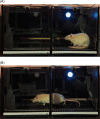Contribution of the Roman rat lines/strains to personality neuroscience: neurobehavioral modeling of internalizing/externalizing psychopathologies
- PMID: 38107777
- PMCID: PMC10725777
- DOI: 10.1017/pen.2023.7
Contribution of the Roman rat lines/strains to personality neuroscience: neurobehavioral modeling of internalizing/externalizing psychopathologies
Abstract
The Roman high-avoidance (RHA) and low-avoidance (RLA) rat lines/strains were established in Rome through bidirectional selection of Wistar rats for rapid (RHA) or extremely poor (RLA) acquisition of a two-way active avoidance task. Relative to RHAs, RLA rats exhibit enhanced threat sensitivity, anxiety, fear and vulnerability to stress, a passive coping style and increased sensitivity to frustration. Thus, RLA rats' phenotypic profile falls well within the "internalizing" behavior spectrum. Compared with RLAs and other rat strains/stocks, RHAs present increased impulsivity and reward sensitivity, deficits in social behavior and attentional/cognitive processes, novelty-induced hyper-locomotion and vulnerability to psychostimulant sensitization and drug addiction. Thus, RHA rats' phenotypes are consistent with a "disinhibiting externalizing" profile. Many neurobiological/molecular traits differentiate both rat lines/strains. For example, relative to RLA rats, RHAs exhibit decreased function of the prefrontal cortex (PFC), hippocampus and amygdala, increased functional tone of the mesolimbic dopamine system, a deficit of central metabotropic glutamate-2 (mGlu2) receptors, increased density of serotonin 5-HT2A receptors in the PFC, impairment of GABAergic transmission in the PFC, alterations of several synaptic markers and increased density of pyramidal immature dendrític spines in the PFC. These characteristics suggest an immature brain of RHA rats and are reminiscent of schizophrenia features like hypofrontality and disruption of the excitation/inhibition cortical balance. We review evidence supporting RLA rats as a valid model of anxiety/fear, stress and frustration vulnerability, whereas RHA rats represent a promising translational model of neurodevelopmental alterations related to impulsivity, schizophrenia-relevant features and comorbidity with drug addiction vulnerability.
Keywords: Roman high- and low-avoidance rats; externalizing disorders; internalizing disorders; neurobiology; reward sensitivity; threat sensitivity.
© The Author(s) 2023.
Conflict of interest statement
The authors have nothing to disclose.
Figures

Similar articles
-
Neurobehavioral and neurodevelopmental profiles of a heuristic genetic model of differential schizophrenia- and addiction-relevant features: The RHA vs. RLA rats.Neurosci Biobehav Rev. 2021 Dec;131:597-617. doi: 10.1016/j.neubiorev.2021.09.042. Epub 2021 Sep 24. Neurosci Biobehav Rev. 2021. PMID: 34571119 Review.
-
5-HT(2A) and mGlu2 receptor binding levels are related to differences in impulsive behavior in the Roman Low- (RLA) and High- (RHA) avoidance rat strains.Neuroscience. 2014 Mar 28;263:36-45. doi: 10.1016/j.neuroscience.2013.12.063. Epub 2014 Jan 8. Neuroscience. 2014. PMID: 24412375
-
Schizophrenia-relevant social, attentional and cognitive traits in female RHA vs. RLA rats: Effects of neonatal handling.Behav Brain Res. 2024 Feb 29;459:114762. doi: 10.1016/j.bbr.2023.114762. Epub 2023 Nov 15. Behav Brain Res. 2024. PMID: 37977340
-
Decreased social interaction in the RHA rat model of schizophrenia-relevant features: Modulation by neonatal handling.Behav Processes. 2021 Jul;188:104397. doi: 10.1016/j.beproc.2021.104397. Epub 2021 Apr 20. Behav Processes. 2021. PMID: 33887361
-
The psychogenetically selected Roman high- and low-avoidance rat lines: a model to study the individual vulnerability to drug addiction.Neurosci Biobehav Rev. 2007;31(1):148-63. doi: 10.1016/j.neubiorev.2006.07.008. Neurosci Biobehav Rev. 2007. PMID: 17164110 Review.
Cited by
-
Neonatal Handling Positively Modulates Anxiety, Sensorimotor Gating, Working Memory, and Cortico-Hippocampal Neuroplastic Adaptations in Two Genetically Selected Rat Strains Differing in Emotional and Cognitive Traits.Brain Sci. 2025 Jul 22;15(8):776. doi: 10.3390/brainsci15080776. Brain Sci. 2025. PMID: 40867109 Free PMC article.
-
Non-human contributions to personality neuroscience: From fish through primates - a concluding editorial overview.Personal Neurosci. 2024 Feb 6;7:e5. doi: 10.1017/pen.2024.1. eCollection 2024. Personal Neurosci. 2024. PMID: 38384664 Free PMC article.
References
-
- Amsel, A. (1992). Frustration theory: an analysis of dispositional learning and memory. Cambridge: Cambridge University Press.
-
- Andión, O. , Caseras, X. , Fullana, M.A. , Fernández-Teruel, A. , Ferrer, M. , Casas, M. , & Torrubia R. (2013). Cued aversive classical conditioning in humans: The role of trait-anxiety. Open Journal of Psychiatry, 3, 230–237. 10.4236/ojpsych.2013.32021 - DOI
-
- Barrós-Loscertales, A. , Meseguer, V. , Sanjuán, A. , Belloch, V. , Parcet, M. A. , Torrubia, R. & Avila, C. (2006). Behavioral Inhibition System activity is associated with increased amygdala and hippocampal gray matter volume: A voxel-based morphometry study. Neuroimage, 33, 1011–1015. 10.1016/j.neuroimage.2006.07.025 - DOI - PubMed
Publication types
LinkOut - more resources
Full Text Sources
Miscellaneous
